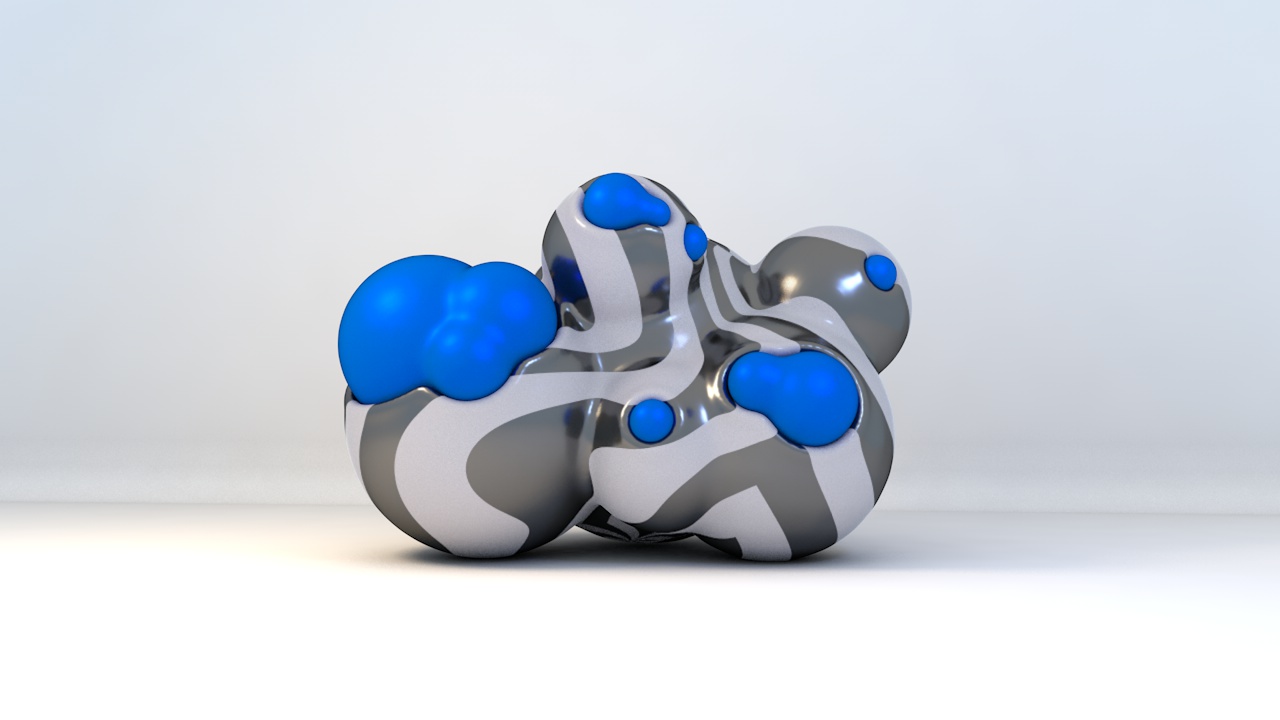-
Posts
2,052 -
Joined
-
Last visited
-
Days Won
119
Content Type
Profiles
Blogs
Forums
Gallery
Pipeline Tools
3D Wiki
Plugin List
Store
Downloads
Everything posted by HappyPolygon
-
that's nice. I see why they moved it but it's not enough of a reason to do it though... It makes it look like the function is intended only for sculpting ...
-
I think they removed the "Project Mesh" because the Surface Deformer does exactly that non-destructively ... But to be honest I don't think this could work in this case...
-

Reduce polygons in a selection rather than an entire object?
HappyPolygon replied to Bovellum's topic in Cinema 4D
I believe Fields will soon make an appearance on Subdivision, Reduce Polygon and ReMesh soon. But for now I would just duplicate the mesh, keep the part for remeshing from the copy and keep the rest of the part from the original, and then connect the two objects back to one. -
This rig serves the same role, just change the orientation of the smaller circle. Substituting the smaller circle to a rectangle or triangle also produces interesting effects. The more the orbiting circles the more complex the result... also changing the trace point distance from the inner most circles change the results. https://en.wikipedia.org/wiki/Hypocycloid https://en.wikipedia.org/wiki/Epicycloid https://en.wikipedia.org/wiki/Hypotrochoid https://en.wikipedia.org/wiki/Epitrochoid
- 38 replies
-
- SideFX
- Blender Foundation
-
(and 1 more)
Tagged with:
-
I think @MODODO has a lot to throw in here.... And I hope @jackTheStorm updates some of his experiments to R25/S26 and also throw them here.
-
This is a very cool update but it is still far behind Corel. I want to detach from Corel but Affinity and Inscape still have a lot of gaps to fill. Their biggest disadvantage towards Corel is their poor vector tracer. Corel seems to have a less destructive workflow. Inkscape is a fully vector graphics app, compared to Corel Draw it lacks a lot of bitmap in-app editing. Inkscape has a lot of cool plugins but most of them don't work with the latest updates. Inkscape has a less intuitive workflow, I had to search in google how to apply a simply gradient transparency on a bitmap object. If only Inkscape had regular updates as Blender. I really want Affinity Publisher to be better but probably their roadmap doesn't lead to professional book publishing, only magazine-type publishing. I think Corel is closer to C4D concerning the user-friendly and intuitive GUI. Inkscape's 1.2 Tilling Effects reminds me of C4D's MoGraph, I was hopping for a very long time for Corel to come up with something similar.
-

Direction variation when emitting from an object in x-particles?
HappyPolygon replied to Tread's topic in Cinema 4D
On polygonal objects particles inherit their direction from the polygon normals. With that information you could try to fake a spread using randomly (or semi-randomly) rotated triangle polygons along the surface of the emitter object using MoGraph and emit particles from them instead. -
Gavin Shapiro has been making looping VJ videos featuring penguins and flamingos for quite some time. Official site His technical skills for creating never-ending zoom/scale self-similar geometries procedurally fascinated me the first time I saw them. Later he made a tutorial (and guest-starred on Rocket Lasso) explaining the methods he used. The following video is his latest creation. This is the first time I see a so well done 3D optical illusion. Feel free to geek-out on speculating how he could have made those penguins travel on the same path from two different viewing angles at the same time.
-
This is at step 8. The Axis Node Capsule can move the pivot axis of the rake anywhere inside the bounding box of the rake. It doesn't have to be the rake model itself, you can use a proxy cube and make the sphere fields and rake model a child of that and have the Capsule manipulate only the proxy. Frame 0, pivot point at -100% z-axis, make a half-turn from frame 0 to 50 frame 50, pivot point at +100% z-axis make a half-turn from frame 50 to 100 ... and so on Consecutive clock-wise or anticlock-wise turns will trace something like this The steps go R -> G -> B -> Y But interchangeable anti-clock-wise and clock-wise turns will trace a zig-zag line like this
- 38 replies
-
1
-
- SideFX
- Blender Foundation
-
(and 1 more)
Tagged with:
-
I was going to propose to make a reverse engineering of the Asset Library's wonderful example scene when first Volume Builder/Mesher were introduced featuring a boy and girl cartoon ice-creams but I couldn't even find an image online 'cause I don't currently have access to the online content. I just wasn't even sure if the file contained enough of the original setup or if they made most of it "editable" before passing it to the VB.
-
Great source : https://www.toolfarm.com/tutorial/c4d_spotlight_python_to_expand_cinema_4d/ You can find similar posts here:
-
Not even close... Here's what to do: Find or make a nice sand texture/shader an apply it on a plane with about 100x100 or 50x50 polygons. Make plane editable and apply a 50% intensity to the vertex map. Make 3 spheres and put them close to each other. */** Put a trio to each end of the fork. Manipulate the vertex map using the spheres as fields. Make the middle sphere adjust the vertex map intensity locally to 0% and the others to 100%. Use the Freeze filter to maintain the effect. Use the same vertex map to drive either a Displacer modifier or a Sub-Polygon Displacement material channel (simple white color). For the animation I would use the Axis Node to manipulate the pivot (object center) of the fork. *About Step 3 and 4 I think that even a single sphere can do the trick with a spline remapping. I'm not sure if a spline itself could drive the vertex map like that. ** Alternatively you could use no spheres at all. Just put a null and trace it. Use the trace object as a spline field with remapping.
- 38 replies
-
1
-
- SideFX
- Blender Foundation
-
(and 1 more)
Tagged with:
-
Did this really worth the effort ? I thought people did these kind of things using PS to make a z-pass and assign it to the Sub-Polygon Displacer.... (if not the Normal Channel)
- 107 replies
-
- Blender Foundation
- Maxon
-
(and 1 more)
Tagged with:
-
Could you upload the wireframe render ? It's hard to understand the geometry with this kind of Phong. I don't see why this is hard to make in C4D ... Isn't it a simple sweep ?
- 107 replies
-
1
-
- Blender Foundation
- Maxon
-
(and 1 more)
Tagged with:
-

Koch snowflake recursive problems - potential scene nodes bug?
HappyPolygon replied to a topic in Nodes
I'll have to wait 5 months to have a look at it 😥 when I get back home. (old laptop doesn't support the new open GL and Cuda) -
I've tried promoting your question to Chris Smidt in his last Rocket Lasso Live but I lost connection during the first half hour for the next two days. He loves simulation puzzles. I don't know what happened to the rest of the Live I'm waiting for the upload. Fortunately we have MODODO. @MODODO what kind of object is the Edge to Spline ? It has a custom icon. Is it a plugin or a Capsule ?
-
I was thinking the exact same setup but without TP. I think this can be done with just the Field Force. Rocket Lasso had a nice example back when it was introduced, don't have time to find it though :(.
-

Constrain clones to an object surface using Constraint tag ...
HappyPolygon replied to Isca's topic in Cinema 4D
I think what you are looking for resembles something very close to, if not the Curl Noise (R21), it self. I'm not sure if it's possible to assign clones on particle position (probably possible through XPresso but I've never looked at the MoGraph section). Otherwise you can certainly assign any object as a particle. The only problem I can think of is the orientation of it. If it were a clone that wouldn't be an issue but as a particle that's something someone with more knowledge has to have a look at. -

Koch snowflake recursive problems - potential scene nodes bug?
HappyPolygon replied to a topic in Nodes
That's an interesting number. Thanks for the book. So basically you re-wrote the L-system script interpreter using nodes ? Respect. -

Koch snowflake recursive problems - potential scene nodes bug?
HappyPolygon replied to a topic in Nodes
I love it. What exactly does the Koch Divider do ? -

Constrain clones to an object surface using Constraint tag ...
HappyPolygon replied to Isca's topic in Cinema 4D
By definition the Cloner will constrain your clones on the surface of an object. What kind of problem do you face were the cloner does not behave as expected ? Or do you want to know if there is an other way to do it ? -

Avatar 2: The Way of Water Trailer now at IMDB
HappyPolygon replied to 3D-Pangel's topic in Discussions
To me it sounds really unnecessary. It sounds like he raised more than enough money for the movie that he chose to do it the hard way just to justify the expenses. No movie ever required from actors to fold their breath for 4 minutes ! It's supposed to be a fully CG movie... well at least most of the time. We'll be able to judge the methods once we see the movie first. -
I think that the gore part is mandatory in this series. I haven't read this anywhere but I think that the stories have to include at least two elements of the Love, Death and Robots title. If you look closely to each episode you will find at least 2 of these elements that secretly drive the stories.
-
Join Jules Urbach as he presents his vision for the future of GPU rendering and how it will impact gaming, VFX, media, design, and cryptoart in the 2020s and beyond. He will discuss the roadmap for OctaneRender 2022 and The Render Network, the industry’s first blockchain distributed GPU rendering network and 3D marketplace. Jules will also detail how the future of media lies in holographics, light field technologies, and real-time rendering, and how OTOY is working to help drive that future through OctaneRender 2022, Brigade, and The Render Network. The presentation also contains some nice new AI rendering features.

